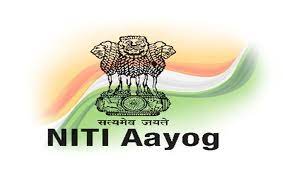NITI Aayog Celebrates 10 Years

- 06 Jan 2025
In News:
- NITI Aayog, the National Institution for Transforming India, completed its 10th anniversary on January 1, 2025.
- Established to replace the Planning Commission, NITI Aayog was designed to address contemporary challenges such as sustainable development, innovation, and decentralization in a dynamic, market-driven economy.
About NITI Aayog
Establishment and Mandate
- Formation: Created through a Union Cabinet resolution in 2015.
- Primary Mandates:
- Overseeing the adoption and monitoring of the Sustainable Development Goals (SDGs).
- Promoting competitive and cooperative federalism between States and Union Territories.
Composition
- Chairperson: Prime Minister of India.
- Governing Council: Includes Chief Ministers (CMs) of all States and UTs, Lt. Governors, the Vice Chairperson, full-time members, and special invitees.
- CEO: Appointed by the PM for a fixed tenure.
Key Achievements
Policy Advisory and Decentralized Governance
- Shifted focus from financial allocation to policy advisory roles.
- Promoted decentralized governance through data-driven initiatives like the SDG India Index and the Composite Water Management Index.
Innovative Initiatives
- Aspirational Blocks Programme (2023): Focused on 500 underdeveloped blocks for 100% coverage of government schemes.
- Atal Innovation Mission (AIM): Trained over 1 crore students through Atal Tinkering Labs and incubation centres.
- Initiatives like e-Mobility, Green Hydrogen, and the Production-Linked Incentive (PLI) Scheme were conceptualized to drive innovation and sustainability.
Role and Functions of NITI Aayog
Strategic Advice and Federal Cooperation
- Provides policy formulation and strategic advice to both central and state governments.
- Fosters cooperative federalism by encouraging collaboration between the central and state governments.
Monitoring and Evaluation
- Plays a crucial role in monitoring and evaluating policies and programs to ensure alignment with long-term goals.
Promoting Innovation and SDGs
- NITI Aayog contributes to aligning national development programs with the Sustainable Development Goals (SDGs), focusing on innovation, research, and technology in critical sectors.
Key Differences Between Planning Commission and NITI Aayog
Aspect Planning Commission NITI Aayog
Purpose Centralized planning and resource allocation. Focus on cooperative federalism and policy research.
Structure Led by the PM, with Deputy Chairman and full-time members. Led by the PM, with Vice-Chairperson, CEO, and Governing Council.
Approach Top-down, centralized. Bottom-up, encouraging state participation.
Role in Governance Executive authority over policies. Advisory body without enforcement power.
Five-Year Plans Formulated and implemented. Focus on long-term development, no Five-Year Plans.
Challenges Faced by NITI Aayog
- Limited Executive Power: Lacks authority to enforce its recommendations, restricting its influence.
- Coordination Issues: Achieving effective collaboration between central and state governments remains challenging.
- Data Gaps: Inconsistent state-level data hampers accurate policymaking and evaluation.
- Resource Constraints: Limited resources hinder full implementation of initiatives.
- Resistance to Change: Some states resist NITI Aayog's initiatives due to concerns over autonomy and alignment with local needs.
Future Vision and Planning
- Agenda for 2030: Focus on achieving the Sustainable Development Goals (SDGs) in areas like poverty alleviation, education, healthcare, clean energy, and gender equality.
- Vision for 2035: NITI Aayog's 15-year vision document aims for sustainable, inclusive growth, with an emphasis on economic growth, social equity, and environmental sustainability.
- Innovation and Digitalization: Promotes digitalization and innovation through data-driven policymaking and regional focus on tribal and hilly areas.
Conclusion: Reflections on the First Decade
- Despite significant achievements, NITI Aayog’s influence remains limited by its advisory role and resource constraints.
- The shift away from centralized planning, evident since the dissolution of the Planning Commission, has sparked debate about the effectiveness of such a model in ensuring long-term development and inclusive growth.
